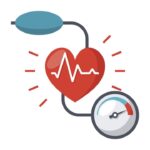Heart failure (HF), a perilous cardiovascular condition with a high incidence rate, is characterized by weakened cardiac contractions leading to inefficient blood pumping and slower circulation throughout the body. To gain a comprehensive understanding of what heart failure entails, let’s delve into the following medical discourse.
1. Definition of Heart Failure
Heart failure refers to the diminished ability of the heart to contract effectively, resulting in inefficient blood pumping to nourish the body. The slowed circulation affects blood flow through the heart and the entire body. The root causes of this condition stem from abnormalities in the structure or function of the heart.

Common symptoms of HF disease include shortness of breath, excessive fatigue, swelling in the legs, ankles and feet, rapid or irregular heartbeat
2. Causes and Factors Contributing to This Condition
2.1. Causes of Heart Failure
– Coronary artery disease: acute coronary syndrome, localized myocardial ischemia, etc.
– Valvular stenosis, including aortic or mitral valve stenosis
– Congenital heart diseases with intracardiac shunts such as ventricular septal defects, patent ductus arteriosus, etc.
– Non-ischemic dilated cardiomyopathy
– Genetic or familial predisposition
– Inflammatory conditions or infections causing damage
– Medication-induced damage or toxicity
– Endocrine disorders like thyroid dysfunction, diabetes
– Viral infections or infectious agents
– Chronic arrhythmias

Arrhythmia is one of the causes of HF
2.2. Contributing Factors to Worsening HF
– High-sodium diet
– Non-compliance with treatment protocols, irregular medication intake
– Reduction of prescribed medication dosage without consulting a physician
– Arrhythmias
– Infections
– Anemia
– Additional medications exacerbating this syndrome, such as calcium channel blockers, beta-blockers, non-steroidal anti-inflammatory drugs, anti-arrhythmics
– Excessive alcohol or alcohol-containing beverages consumption
– Pregnancy
3. Classification of Heart Failure Subtypes
Various clinical classifications aid physicians in tailoring appropriate treatment plans.
3.1. Left-Sided Heart Failure
Patients in this category exhibit symptoms of pulmonary congestion, including fatigue, exertional dyspnea, orthopnea, cough with hemoptysis, etc.
3.2. Right-Sided Heart Failure
Patients with right-sided heart failure manifest peripheral congestion symptoms, such as pedal edema, hepatomegaly, ascites, and prominent jugular venous pulsations.
3.3. Biventricular Heart Failure
Individuals with symptoms indicative of both left and right-sided heart failure.
3.4. Acute Heart Failure
Acute HF presents with severe dyspnea, acute pulmonary edema, or cardiogenic shock, requiring urgent intervention to prevent life-threatening complications.
3.5. Chronic Heart Failure
Subtle symptoms may persist in individuals with a history of acute HF, but the condition has stabilized and improved.
3.6. Heart Failure with Reduced Ejection Fraction
The heart’s ability to contract, measured as ejection fraction, is reduced, typically below 40%.
3.7. Heart Failure with Preserved Ejection Fraction:
Despite preserved ejection fraction, impaired ventricular relaxation or increased stiffness leads to HF symptoms.
4. Dangers of HF and Patient Care Guidelines
4.1. Is HF a Dangerous Condition?
This condition poses a grave threat, impacting the patient’s quality of life and longevity.
– Reduced quality of life: Patients struggle with daily activities, requiring constant care.
– Arrhythmias: Increased risk of atrial or ventricular arrhythmias leading to cardiac arrest.
– Mortality: Severe HF disease, unresponsive to internal medicine treatment, poses a significant risk of death, even without advanced progression.

Untreated HF can eventually lead to many dangerous health complications
4.2. Guidelines for Caring for HF Patients
Prognosis of HF disease varies based on the underlying causes, treatment methods, and timely detection. Patients and their caregivers must be well-informed to prevent the disease or slow its progression effectively.
– Maintain a healthy lifestyle with moderate exercise like walking or yoga for at least 30 minutes daily.
– Avoid strenuous activities and excessive exertion.
– Quit smoking and limit alcohol consumption, as these factors contribute to disease exacerbation.
– Manage stress, maintain a positive outlook, and emotional well-being.
– Maintain a healthy weight, avoiding obesity, which places extra strain on the heart.
– Adopt a balanced diet rich in fruits and vegetables, low in fats and oils.
– Attend regular check-ups, adhere to prescribed medications, and follow physicians’ instructions.
It is crucial to recognize warning signs and seek medical attention promptly, especially if experiencing rapid weight gain, edema, difficulty breathing, fainting, chest pain, or persistent fatigue. Early intervention can significantly impact the trajectory of HF, enhancing both the quality and duration of life. Regular cardiology consultations and timely adherence to medical advice are paramount in managing this global health concern effectively.








